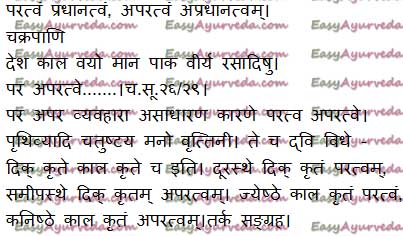Paratva Aparatva Gunas – Meaning, Benefits
By Dr Raghuram Y.S. MD (Ay) & Dr Manasa, B.A.M.S
Gunas are the qualities contained in the substance. Qualities explained in Ayurveda are broadly classified into Adhibhoutika and Adhyatmika categories.
Read – Dravya: Meaning, Ayurvedic Explanation
Table of Contents
Introduction
Adhibhoutika qualities are classified into Samanya (general qualities) and Vishishta (special qualities).
Samanya qualities are further sub-classified into Gurvadi 20 qualities and Paradi 10 qualities.
Read – Rasa Panchaka – 5 Qualities Of Substance (Dravya)
Paratva – Aparatva Gunas
Paratva and Aparatva are paired qualities among the paradi qualities. They are exactly opposite to each other. Paratva means the best. Aparatva means the least.
Read – Adhyatmika Gunas – Qualities Related To Soul As Per Ayurveda
Paratva
Paratva is also called as shreshtatva, utkrushtatva or pradhanatva, all of which mean ‘the best one’.
Aparatva
Aparatva is also called nikrushtatva or apradhanatva, all of which mean ‘the inferior one’.
Read – Extra Qualities (Gunas) Enumerated By Master Sushruta
Paratva and Aparatva qualities – Determining factors of superiority and inferiority (respectively) of land, season, age etc factors
Meaning of Paratva
Paratva
It determines the superior aspects of region, time etc factors.
The qualities which denote superior aspects regarding the below mentioned factors is called paratva. Those aspects are –
- Desha – region / land
- Kala – time / season
- Vaya – age
- Mana – quantum
- Paka – transformation / processing / digestion
- Virya – potency
- Rasa – taste (read about – Taste in Ayurveda)
- Prakruti – constitution (read about body constitution)
- Bala – strength / immunity and endurance
Thus, paratva is helpful in deciding the superiority of each of the above mentioned factors.
Read – How To Make Prognosis Of Disease According To Ayurveda?
Aparatva
It determines the inferior aspects of region, time etc factors.
The qualities which denote insignificant / inferior aspects regarding the below mentioned factors is called aparatva. Those aspects are –
- Desha – region / land / geography / place
- Kala – time / season
- Vaya – age
- Mana – quantum
- Paka – transformation / processing / digestion
- Virya – potency
- Rasa – taste
- Prakruti – constitution
- Bala – strength / immunity and endurance (read about immunity in Ayurveda)
Thus, aparatva is helpful in deciding the inferiority of each of the above mentioned factors.
Examples
Among the lands – desert land (maru desha) is superior and marshy land (anupa desha) is inferior.
Among the seasons – cold predominant and energy giving seasons are considered to be superior (read about – visarga kala) and hot and energy depleting seasons (read about – adana kala) are considered to be inferior.
Among the ages – the taruna avastha i.e. teenage / early middle age is said to be superior and other ages are said to be inferior.
Among the quantum – the prakruta mana i.e. normal measurements of body parts are said to be superior and other variable measurements are said to be inferior.
Read – Anguli Pramana: Linear Measurement As Per Ayurveda
Among the constitution – the kapha constitution is said to be superior one while the vata constitution is said to be inferior one. Pitta is intermediate in quality.
Read – Diet And Lifestyle Advice For Kapha Dosha Body Type
Among the strength and immunity – the people who have optimum strength are said to be superior and those having less strength are said to be inferior.
Among the other factors i.e. digestion, potency, taste etc are said to be superior when they are yougika i.e. made use of / beneficial and are said to be inferior when they are ayougika i.e. not made use of / non-beneficial to the body.
Read – Understanding Digestion Process From An Ayurveda View
Sanskrit verse

Important aspects
Other important aspects of Paratva and Aparatva qualities
Qualities which explain the sannikrushta vishayas i.e. near off objects and subjects are called paratva qualities. This means to tell that paratva quality explains the near off objects and subjects.
Similarly, the qualities which explain the viprakrushta vishayas i.e. far off objects and subjects are called aparatva qualities. This means to tell that aparatva quality explains the far off objects and subjects.
Read – 16 Factors To Watch For A Healthy Mind And Body
The far off and near off aspects when related to place is called daishika and when related to the time is called kaalika. Both these are also determined by paratva and aparatva qualities.
Example –
the aspects near off place and near off time are explained by paratva quality. The aspects like far off place and far off time are explained by aparatva quality.
Uncommon / extraordinary reasons or causes (determining factor) for conversations like ‘This is closer i.e. para and that is far off i.e. apara’ are paratva and aparatva qualities respectively.
The paratva and aparatva qualities are said to be present in earth element, water element, fire element, air element and mind.
Read – Panchamahabhuta: Application, Areas of Utility in Ayurveda treatment
Para, Apara types
Types of Paratva and Aparatva
Paratva and Aparatva are of two types i.e.
1. Dik kruta paratva and dik kruta aparatva –
This type of paratva and aparatva are related to the direction and distance. Dik kruta paratva is present in the far off objects and dik kruta aparatva is present in the near off objects.
2. Kala kruta paratva and kala kruta aparatva –
This type of paratva and aparatva are related to the time factor. Kala kruta paratva is present in the bigger / larger things and kala kruta aparatva is present in the smaller things.
Click to Consult Dr Raghuram Y.S. MD (Ayu) – Email / Skype









